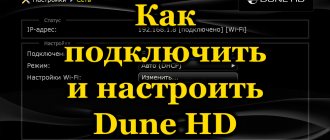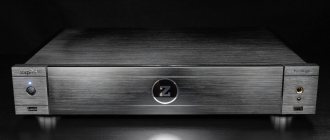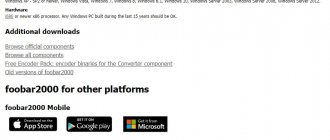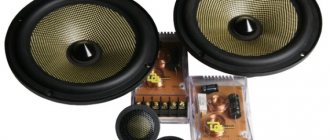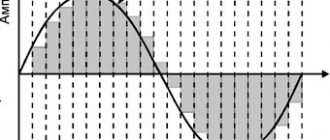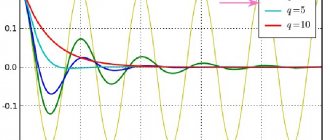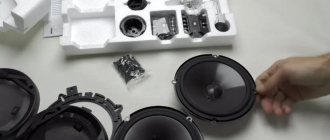At work. Testing on different types of content
First, a few words about performance in general. The system works quickly, but visually it is slightly inferior in speed to the flagship solutions based on AMLogic S912 (which costs on average 2+ times less). But in our case, this is not important, but the operation of the VPU with all the optimizations. Zappiti One 4K HDR plays all modern audio and video formats that match the capabilities of the Realtek RTD1295 chip. And they are almost maximum, considering that only basic HDR formats will be available to you (and not everything in a row). The key component is the Realtek system video player, which each manufacturer improves to suit its needs. Zappiti software is a layer between the Riltek player and the user. All the latest standards are supported: 4K HDR, HEVC/H.265, Rec.2020, as well as object-based audio in Dolby Atmos and DTS-X. Fans of Lossless audio files will also enjoy the omnivorous nature of One 4K HDR. In addition, the built-in video processor makes high-quality upscaling of any content up to 4K resolution and uses proprietary Zappiti MagicPixel v2 image processing algorithms. The media player does an excellent job of decoding any H.265 UHD BDRip, UHD BD Remux (10 bit 2160p) and 4K UHD Blu-ray itself. Even test demos are played with bitrates of 150 Mbit/s (not tested further, but stated to be up to 400). There are also no problems with decoding 3D BD ISO, MKV 3D MVC, you can adjust the 3D depth. BDRip, BD Remux and honest H.264 1080p60 are easy to play. But in the case of 4K H.264, the maximum number of frames is 24.
There are no visual complaints about HDR support. There is an HDR>SDR conversion function if you play HDR video and your TV does not support the format. Without it, all HDR content is output with faded, incorrect color reproduction. It is poorly implemented (in comparison with players based on the flagship Hisilicon chip), and in addition there is an annoying bug. The hdmi range mode settings are lost if you connect to a non-HDR TV after watching content with HDR>SDR conversion. The autoframe rate works correctly, and this has long been an indicator of the premium nature of players. If we subjectively evaluate the quality of the output video, then it is very good (about 8.5 versus 10 for the Oppo 203). There is a bit of banding. Everything is perfect with the Zappiti One 4K HDR audio output to the receiver. Audio tracks in DTS-HD MA 7.1, Dolby TrueHD 7.1, Dolby Atmos 7.1 and DTS:X 7.1 are digested with a bang. Any multichannel can be output as LPCM over HDMI, and there is Dolby Atmos to Dolby Digital transcoding.
The video player works with ISO images and BDMV folders. As noted earlier, we tested the latest beta 3.12, which finally introduced support for Blu-ray menus. The presence of this function is already pleasing, but so far everything works like any “Chinese” and cannot work with forced titles hidden inside full Java disks (Fox, Sony, Lionsgate).
We checked the operation of Torrent Stream Controller or Ace Stream Media in conjunction with the system video player. Everything is perfect including rewind and auto frame rate. There are no comments on the work of the popular HD VideoBox program - everything is fine. IPTV fans will also be pleased. The speeds of working with drives are good. Read/write from the hard drive reaches 110, and an external USB 3.0 drive showed a speed of 78 MB/s. The Gigabit Ethernet connection in tests showed 900+ Mbit/s and more than covers all the needs over a wired network, but Wi-Fi when connected to a Linksys router using the 802.11ac standard showed a maximum of only 81 Mbit/s. The average speed was in the range of 63-70 Mbps. Wi-Fi worked flawlessly during testing, but this speed may not be enough for UHD remixes with peak bitrates. This is where the lack of MIMO 2x2 comes into play. Among the disadvantages in everyday work, we note the absence of an NFS client in the native Explorer. Those. without crutches (do everything when starting OpenWrt), there is no way to mount an NFS share and watch the content with your native player. More cons? They are. The player does not support many DRM systems like Widevine, and therefore you have to forget about top legal 4K HDR online services like Netflix. The YouTube client is far from ideal; not all Android applications from Google Play are supported, and so on. In general, the player does not have any critical shortcomings in November 2022, but there is still a feeling of “unfinished” software. Although some of the shortcomings are still observed on all players based on Realtek RTD1295DD and, perhaps, are a problem at the basic level.
Zappiti One 4k HDR - European quality, reliability and appropriate price
Founded in 2010 Zappiti is one of the largest manufacturers of multimedia equipment, 4K media platforms, media centers and video servers. The company's headquarters is located in France, in Paris, and the company's development center is located in the south of France in the city of Montpellier. Initially, the company was engaged in writing software for computers; a little later, Zappiti was developing software for the then well-known Israeli brand Dune HD. A few years later, Zappiti launched its first OEM player models based on Dune HD. The product line consisted of two media players:
Zappiti Player Zappiti Player Mini
CES 2015 brought a number of new products, including a media player
Zappiti Player 4K
The then new Zappiti media player, as you might guess from its name, allowed users to play 4K content (supported both 3840x2160 and 4096x2160 resolutions) encoded with the new DivX UHD HEVC codec. The new functionality also included Ultra HD upscaling from Full HD, a video enhancer and automatic frame rate adjustment (AFR). Zappiti Player 4K ran on a Realtek RTD1195 processor, equipped with a dual-core CPU and GPU, double the amount of RAM and flash memory, and also supported the installation of 3.5″ SATA hard drives with a capacity of up to 6 TB. Zappiti Player 4K is the world's first Android media player that is compatible with HD audio in passthrough mode. Additionally, the player came with Kodi (XBMC) pre-installed and offered the proven Zappiti Media Center V4 solution by default. This software shell is very popular in Europe and allows the media player to analyze your media collection, select covers and meta information for it to subsequently generate a very informative and attractive GUI. The Zappiti Player 4K mini / Zappiti Player 4k / Zappiti Player 4k Duo player on the Realtek RTD1195 processor, which has gained popularity in Europe, will be replaced at the beginning of 2022 by a line of players with the latest Realtek RTD1295DD processor:
the Android 6.0 operating system and the already beloved Zappiti Media Center .
Today we will talk about one of the Zappiti One 4K HDR The retail price of this model in Europe is 299 euros.
The media player came in a white and orange box with a handle, with color printing made of thick cardboard.
Inside the box you can find: media player, IR remote control, Lan cable, HDMI cable, USB - USB OTG (Type C), 12v/2A charger with removable adapters (4 pcs) for different types of sockets.
All this can be seen in the device unboxing video below:
● Chipset: Realtek RTD1295. ● CPU: ARM® Cortex® CA53 x4 (Quad Core). ● GPU: Mali™-T820 MP3 (3 cores) (equivalent to Octa-core Mali 450) - DirectX 11.1, OpenGLES 3.1, OpenGL 1.2, FP, ASTC, Renderscript. 4x Multisampling Anti-Aliasing (MSAA). ● Operating system: 64-bit. ● DSP: Hardware accelerated video and audio DSP. Native support for 10-bit YUV. Optimize hardware performance for the Zappiti user interface. ● Cache: 1 MB L2. ● RAM: 2 GB DDR3. ● NAN eMMC: 16 GB (5.0), 8 GB in Zappiti Mini 4K HDR version. ● Connectors: HDMI 2.0a (TX/RX, CEC, Deep Color, 12bit, xvYCC, MHL 3.0), 3x USB 2.0, 1x USB 3.0, 1x USB Type-C, CVBS analog video (both analog and digital video outputs (Analog and digital video outputs simultaneously), Coaxial and optical audio output S/PDIF (Toslink), Gigabit Ethernet, Wi-Fi 5G, SD/MMC card slot, AC jack, AC On/Off button (rear), LED display on front panel controlled by RC ● Hot swappable HDD Rack option: easy and quick to insert and remove (Mini - 1 external, One - 1 internal, Duo - 2 internal) 3.5" HDD SATA drives ● Media sources: External HDD (USB), USB devices (USB flash drive, USB card reader, etc.), Built-in SD reader (SD/SDHC/MMC), PC and NAS in local network (SMB, UPnP, HTTP), Other sources of information on the Internet and local network Multi-bay USB external drives supported ● Internet browser Connect a computer mouse and keyboard to browse the Internet like on a computer. ● DLNA: Full support for DLNA standard (1.5 or 2.0). ● SMB Server: Zappiti Share, OpenWRT ● Video Codecs: HEVC, H.265, x265 (up to 60p in 4K), MVC, AVC, MPEG-2, MPEG-4, VC-1, H.264/x.264 (up to Full HD 60p and 4K 24p), FLV, AVS, XVID, DIVX (from version 4), Sorenson Spark L70, VP9 HW (up to 4K 60p); Ultra-high bitrate support (jusqu'à 350 Mbps in HEVC 4K). ● Video file formats: 3D BD ISO, BD ISO, BDMV, MKV, MKV 3D, MK3D, MPEG-TS, MPEG-PS, M2TS, VOB, AVI, MOV, MP4, QT, WebM, DVD-ISO, VIDEO_TS, AVCHD 2.0 (AVCHD 3D, AVHD Progressive). ● Video output flexibility: output video in any resolution and format from SD to 1080p, Ultra HD (3840x2160) and 4K (4096x2160). Up to 4K 60p. Show your movies in native 24p (23.976Hz output). ● Audio codecs: AC3, DTS MPEG, MP3, AAC, LPCM, ALAC, APE, M4A, AIFF, WAV, VSELP, FLAC, Ogg / Vorbis; Supports lossless format and audio files (up to 192 kHz / 32 bit). ● Audio playback functions: support album/artist/category cover thumbnails (folder.jpg), folder playback, shuffle playback (shuffle playback), playlist repeat, repeat playback. Musical slideshow for live concerts. Displays the inside pages of an album booklet or back cover. ● Multi-channel home theater sound: Bitstream, stereo mixing (DTS, DTS-HD MA, DTS-HD HRA, DTS: X, Dolby Digital, Dolby Digital EX, Dolby Digital Plus, Dolby TrueHD, Dolby Atmos). ● Subtitle formats: SRT (external), SUB (MicroDVD) (external), Text (MKV), SSA/ASS (MKV, external), VobSub (MP4, MKV, SUB/IDX external), PGS (BD ISO, BDMV, M2TS, MKV), DVBSUB (DVB-T, DVB-S, DVB-C). ● 3D hardware acceleration: OpenGL. ● Photo file formats: JPEG (hardware decoding), PNG, BMP, GIF (up to 8192x8192). Music slide show option with dynamic transition effects. ● Formatting supported: FAT16 / FAT32 (read-write), EXT2 / EXT3 (read-write), NTFS (read-write), Mac OS Enhanced (read-write). ● Ethernet: 10/100/1000 Mbit/s. ● Wi-Fi: 8IEEE 802.11a/b/g/n, 802.11AC, 2.4GHz/4.900GHz~5.845GHz (5.0GHz ISM band). Two-way. Dual external antenna. ● Bluetooth 4.0: BT4.0 ● Android 6.0: install and use additional applications via GooglePlay. Warning! Some Android apps are not suitable for use with the remote control. In this case, use a connected computer mouse or AirMouse (not supplied). ● Audio/Photo/Video Mirroring: Mirror the display and sound of an Android or iOS device to your TV, show photos from a recent trip, or listen to your favorite songs. ● Network Playback: Special network optimization ensures better LAN playback performance no matter what media type supports SMB protocol (including HHVC UHD files) via Gigabit Ethernet or 10/100 Ethernet. ● Universal RC: Easily integrates into a smart home setup via ready-to-use Control4 driver, RTI Crestron IP codes driver, Logitech, Pronto and general IP codes. Power supply and power on/off button.
The device has an aluminum body with dimensions: 28cm x 18cm x 5cm
The weight of the device is 1411 grams.
On the front of the case is the company logo, a large letter “Z”, which is illuminated with blue light. The backlight on/off function is controlled from the remote control.
The remote control also has two modes, with and without backlighting, and the remote control also has a row of learnable keys at the bottom:
Let's return to the device.
On the left side of the case there are: an SD card slot, a reset button, a USB2.0 port and slots for cooling the device.
On the right side there is a bay for HDD
Rear, from left to right: cooling holes, two USB2.0 ports, AV-out, with standard tulip outputs, Coaxial, USB type C, USB 3.0, Lan 1000M, HDMI out, HDMI in, S/PDIF, block socket power supply and just above the ON/OFF switch. There are two antennas at the edges: WiFi and Bluetooth.
I will not perform a complete disassembly of the device in this review, because... There is a seal on the media player, and if it is broken, I will simply lose the warranty, and the device is not cheap...
The Zappiti One 4k HDR media player came to us with Zappiti OS 3.06 Android 6.0.1 firmware. Having connected the device to a wireless WiFi network, the device offered to update the software to version Zappiti OS 3.07. Which I immediately did...
In terms of basic functionality, this media player is very similar to its brothers based on the Realtek RTD1295 processor, i.e. there is Open-WRT, HDMI CEC.
WiFi operates at 2.4/5G frequencies. During the entire testing period, WiFi worked without failures or freezes.
The media player has its own launcher, the icons are located against the background of red curtains (familiar interface from Dune HD):
The highlight of the Zappiti One 4k HDR media player is the software.
As I said at the very beginning of the review, Zappiti is a company that writes its own software.
And our device has two applications that Zappiti itself developed from scratch: Zappiti Explorer and Zappiti Media Center.
Zappiti Explorer is a file manager developed by the company itself in its own style. In order to enter this file manager, you must enter the code located on the bottom of the device. Those. tied to this device, therefore using the file manager on another device will no longer work.
In essence, it is a regular file manager without any problems in the style of the entire shell as a whole.
But with Zappiti Media Center everything is different. So…
Zappiti Media Center is the pride of the company. It is just as protected as a file manager, i.e. transferring it to any device is almost impossible. there is a strict connection to hardware.
What is Zappiti Media Center and what does it go with?
This is a wonderful cataloger that will be familiar to those who used Dune HD during Zappiti's collaboration with it.
What does this program do? It can process local and network folders for movies, music, clips, and TV series.
Then he searches the Internet for information about them and groups them into a very convenient catalog, which can be divided into groups, for example: films, TV series, etc.
Using this program, you can view a catalog of content, as well as via the SAMBA, UPnP, DLNA 1.5/2.0, or HTTP, and Internet networks. PlayReady, Widevine, HDCP, and DTCP-IP DRM solutions are also implemented.
I actually really liked this software; a huge plus is also that the program is completely translated into Russian, you can select it from the list of available languages. In the application it is possible to select a theme, it is either the default red theme or silver. But the silver one is only available in a paid version, so if you like the silver theme, you will have to fork out an additional 4 euros. And you can buy the theme in the official Zappiti online store.
Media Center does not have its own shell for playing video content, but uses quite standard tools, namely a stock video player.
, Zappiti Media Control software is provided , which is currently under development.
This video player has an auto frame rate; in the new firmware version 3.0.7, a mode switch from HDR to SDR was added to the video player, which is needed to view HDR content on TVs without HDR support. Without this switch, all HDR content is output with faded, incorrect color reproduction. Essentially, this mode adds brightness and richness to colors, provided they are faded. If the colors before switching this mode were normal, then when switching the colors will be too poisonous (I think in the future firmware Zappiti will fix this bug - I have already given information about this to Zappiti, they promised to fix it).
In general, the video player is not much different from the stock Realtek video player; the autoframe rate only works in the stock player; it does not work on third-party ones.
The media player completely lacks Kodi and its variations.
If we do not take into account the problems with the program itself, the device worked perfectly in tandem with TSC, the autoframe rate worked in the system player, the picture did not freeze or crumble into squares.
Also excellent, without any problems.
An IPTV sheet was connected to the software. Channels were viewed without the picture sticking, the image did not crumble into squares.
A version designed for Android TV was installed on the device, which does not have advertising. The program on this media player worked stably but without autoframerate.
SD/HD/Interlace | Zappiti Media Center(Video player) |
| 720 x 576/MP2/mpg/25.000fps - interlaced | |
| 1280 x 720/AVC/MP4/29.970fps | |
| 1920 x 1080/AVC/MKV/25.00fps - interlaced | After a while the video loses synchronization |
| 1920 x 1080/AVC/MKV/23.976fps | |
| 1920 x 1080/AVC/MKV/24.000fps | |
| 1920 x 1080/AVC/MKV/25.000fps | |
| 1920 x 1080/AVC/MKV/29.970fps | |
| 1920 x 1080/AVC/MKV/30.000fps | |
| 1920 x 1080/AVC/MKV/59.970fps | |
| 1920 x 1080/HEVC/ISO/23.976fps | |
| 1920 x 1080/HEVC/MKV/23.976fps | |
| 1920 x 1080/VC-1/MKV/23.976fps | |
| 1920 x 1080/VC-1/MKV/29.970fps - interlaced |
High bitrate | Zappiti Media Center |
| 1920 x 1080/AVC/M2TS/23.976fps & 90mbps | |
| 1920 x 1080/AVC/MKV/23.976fps@100mbps | |
| 1920 x 1080/HEVC/MKV/23.976fps @ 110mbps |
3D | Zappiti Media Center |
| 1920 x 1080/AVC/ISO/23.976fps Frame Packed | Automatically switch TV to 3D mode |
| 1920 x 1080/AVC/MKV/23.976fps Frame Packed | Automatically switch TV to 3D mode |
| 1920 x 1080/AVC/MKV/23.976fps Side by Side | You need to press the 3D button on the remote control |
| 1920 x 1080/AVC/MKV/23.976fps Top & Bottom | You need to press the 3D button on the remote control |
Audio | Zappiti Media Center |
| AAC (Dolby Digital) 5.1 | |
| AC3 (DTS) 5.1 | |
| DTS HD-MA 5.1 | |
| Dolby True HD 5.1 |
Is the Zappiti One 4K HDR media player worth the money? You decide. Yes, it is not cheap and it is worth weighing all the pros and cons.
Firstly, the Zappiti One 4K HDR is not just another TV box for Android, it's designed to be a serious media player, and its own software gives you access to the entire Zappiti Media Center ecosystem, which offers a relatively simple way to organize a local network. It also includes cloud syncing, an additional mobile app, and server software for NAS and PC. The Zappiti One 4k HDR reviewed here includes a hard drive bay.
The build quality is excellent, with silent passive cooling providing added comfort. The media player has many connections. An excellent backlit remote control that fits easily in your hand and is easy to use.
Scanning your media collection in Zappiti Media Center is a simple and convenient process for collecting and cataloging your video content. The only downside to the device is the lack of Kodi and its derivatives.
Overall, the Zappiti One 4K HDR is a truly European product, with good software quality and the same build quality that can compete with the Zidoo line based on the Realtek RTD1295 SoC.
We express our gratitude to the source from which the article was taken, the site tv-box.pp.ua.
You can read the original article here.
conclusions
Pros * Software, cataloger Zappiti Media Center; * Functional and stable system video player; * Full support for 4K HDR, BD3D ISO, any sound; * Normal operation of autoframe; * Fast work with a wired network and Wi-Fi; * USB 3.0 and USB Type-C; * Availability of OpenWrt for advanced users. 50/50 * Minor bugs in the firmware; Cons * The price is too high (from 10,500 UAH or 26,000 rubles).
The media player competes with the Zidoo line based on the Realtek RTD1295 SoC, the new Dune HD Pro 4K/Max 4K/Ultra 4K line, as well as the Himedia Q10 Pro player (based on the Hisilicon chip). Formally, Egreat (on Hisilicon) and Eweat (on Realtek) devices can be added to this series, but they have minimal localization and are inferior in terms of software. Zappiti now has an excellent design on its side, probably the best built-in cataloger and software stability (players have been on the market for a year and a half now). With the Dune 4K line, not everything is clear yet because it is not fully presented, and the software is still very crude. But the competing players Himedia and Zidoo have been on the market for 2 years already (Zidoo has even released new products based on RTD1296), they are at least 25-30% cheaper, but in terms of usability and software stability they are slightly inferior to our hero. And while the leader in the “best picture” category can still be debated for a long time, the “best hardware”, “best software” and “best price” nominations are currently being shown on three different devices. Here and now, the Zappiti One 4K HDR looks like a good buy. True, it is redundant and too expensive for the average user who needs a player with disc installation. In fact, we have before us a media player for integrators/installers and buyers with a full-fledged DC system. Buy in addition the branded Zappiti NAS RIP 4K HDR server and the puzzle will be complete, but your wallet will be empty. If you look at the situation from a different angle, then One 4K HDR is not expensive, but simply niche. As in the case of Dune, the price is higher than the alternatives precisely because of the software. You pay not only for European quality, but also for the interface, ease of use and hassle-free operation. Therefore, we believe that the Zappiti One 4K HDR is the best "4K Home Theater Media Player" on the market at the moment and is worthy of our Gold Award!
The player for testing was provided by the online store hifi-club
Non-high-end form factor
In photographs (and in real life), the player looks like a rather solid and not compact device, although in reality its width is about 28 cm - that is, it is much narrower and, in fact, more compact than typical Hi-Fi components. This impression is partly due to the materials and finishes, as well as the large, attention-grabbing emblem with the letter Z glowing in a dim blue light.
But despite the non-high-end form factor, the player, or rather its version with the SE index, is clearly designed to work as part of a serious multi-channel system, and not to serve as a simple set-top box for a 4K TV. First of all, it has two HDMI outputs: the main one, that is, universal, and for outputting audio streams. Accordingly, the menu provides two settings: with normal signal output and separate, in which the main output transmits only video.
It is believed that this configuration of outputs in players is installed for compatibility with older receivers and sound processors that do not support new video standards. But in fact, such a connection is the most correct from the point of view of image quality, because any receiver or audio processor, when switching, inevitably converts the incoming signals and, albeit slightly, spoils the video, which is still noticeable on large diagonals. But they don’t buy expensive players for simple devices with small diagonals.
The player can be installed in an installation rack with Hi-Fi equipment - Middle Atlantic produces special mounts for this. However, I note that the compartment for hot loading of hard drives is located on the right side, and it will be inconvenient to change them in the rack. And this is clearly not a mistake in positioning: in many installations, disk players are often brought closer to users to make it easier to change these disks, and the remaining components are put away, because a remote control is enough to operate them.
